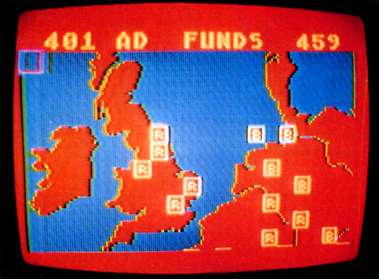Strategy Zone
by Bob Cockcroft

Rome and the Barbarians
KRENtek Software
KRENtek Software
`Rome and the Barbarians' by KRENtek Software is a game that recreates the period when Rome was in a struggle against eastern barbarian tribes. At this time, the empire was in decline, and the once powerful legions were losing their military superiority. As Emperor, it will be your job to resist these invaders, and preserve the empire.

The Roman and Barbarian forces are displayed on a large scrolling map of western Europe. The map, being the surface on which the game is played, scrolls at a speed which is both rapid and playable. Cities, mountains, rivers, and other geographical features are presented in a high degree of detail. The legions are given orders from a joystick controlled command box in a manner similar to that of `Eastern Front'. As in a number of other wargames, troops can be ordered to move in a predetermined path while the player's attention is focused elsewhere. This technique has the obvious advantage of being time efficient. But what really makes the mechanics of movement different in this game, is that the player is able to combine units. One of the most frustrating aspects of some wargames is the inability to concentrate strength at a particular point. Although a player may have many units at his disposal, the maximum power that can be allocated to any point is the combat strength of one unit. Because the game allows the combining of legions, it has gotten around this problem.
`Rome and the Barbarians' depicts this ancient struggle in 3 different ways: militarily, politically, and financially.
This conflict is fundamentally a military one. As a game of ancient warfare `Rome and the Barbarians' does a fairly good job of entertaining and of creating an environment in which numerous strategic options exist: there seem to be few set patterns. The empire can be defended in a number of different ways, although the protection of Italy is essential. Unlike other wargames, the occupation of cities is far more important than the control of territory. `Rome and the Barbarians' uses a real time combat system. There are not any turns; action is continuous. Because commands are given while the `play' is in progress, the game moves quickly. The Emperor must continually move the control box around the map, suppling orders to all his active legions. Although the action may progress a little too quickly, `Real time' gives the game a more realistic presentation.
One of the less attractive aspects of this game is that it uses a multi- screen system. Because one must refer to other displays for information, some of the continuity of the game is lost. The player should not be forced to divide his attention from the main map display on a regular basis.
On another level, `Rome and the Barbarians' is an exercise in diplomacy. Some barbarian tribes can be paid to fight for the empire. However, Rome has a limited supply of funds that can be allocated for bribes. Therefore, it is crucial to correctly choose which barbarians are to be made allies. If carefully picked, paid barbarians can be made to do the majority of the fighting, while the Legions preserve their strength.
Because Rome gets all its income from taxing occupied cities, it is to the empire's advantage to control as many cities as possible. This income is used to pay both the allied barbarians and the Roman legions. Should the Emperor allow the funds in the treasury to fall to zero, all the barbarians and some of the legions would turn against Rome.
Because `Rome and the Barbarians' uses an effective map display, and allows the existence of a number of strategic options, it is an interesting simulation. Although this game uses a multi-screen system, I found it both challenging and enjoyable.